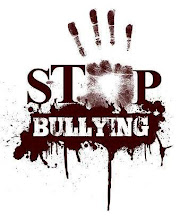A wide range of behaviours have been reported as bullying, including theft. Defining an act as bullying depends on it being intentional, persistent, involving an imbalance of power and because of the negative effect on the victim.
Name calling
Name calling was the most prevalent form of bullying identified in many studies, but an OfStEd report on effective action against bullying in secondary schools reminds us that verbal bullying can often carry a strong hint of violence. The use of modern technology means that this kind of verbal bullying can extend beyond the school day and invade life at home.
Physical bullying
There was a slight increase in physical bullying with age in boys in the Coram study (2003). Sometimes homophobic bullying was said to involve quite serious physical bullying. Older girls reported sexualised bullying with unwanted touching more than did boys.
In an extensive study of over 7000 children, Smith (2000) reported that there is a shift from age eight to sixteen from physical bullying to relational bulling, but that boys experience more physical bullying than girls. Theft can be included in this category as it often involved threats or actual violence.
Social isolation
Behaviour leading to social isolation was reported to be common throughout the age groups, but especially for younger children. This included spreading gossip and ignoring and can be especially difficult to identify.
Homophobic bullying
This is directed towards young people who are openly gay, bisexual, are perceived as gay, or show characteristics often associated with the opposite gender. When heterosexual young people are subject to homophobic bullying they can be less reluctant to report it, as this may reinforce the stereotypical way that they are already viewed by others. The bullying is often verbal, but can also be physical, and in serious cases constitutes assault, leading to investigation by the police. Harassment of a homophobic nature tends to be carried out by groups of people, and occurs often, even daily. Sexual name calling begins in the primary school, although homophobic bullying overall is more common in secondary aged students.
Cyber bullying
This is the latest form of abuse, and as new technologies develop, new forms emerge, such as text and e-mail messaging, and most recently malicious postings on websites. In the Coram study in 2003 cyber bullying was reported by fewer than 5% of pupils but anecdotal evidence suggests the incidence is increasing.
In a survey by National Children's Homes and Tesco mobile in 2005, 20% of young people
aged 11 to 19 years said they had been bullied or received a threat by e-mail, internet chat room or text message.
Racist bullying
This is one area where schools are required to keep statistics about incidents. It is bullying directed at individuals of a certain race, culture or group. For children from ethnic minorities, bullying is more prevalent with 25% of the 2003 Coram study reporting being severely bullied, and 33% of the black and Asian students in Year 8 being bullied this term, more than that reported by white groups (26%). 20% of Year 5 pupils had been called racist names compared with 6% in Year 8 so the nature of the bullying probably changes with age.
*By: Syaziela


